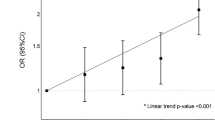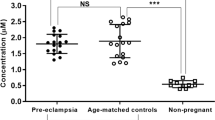Abstract
Interest has been renewed over the role of uric acid in the pathogenesis of hypertension, endothelial dysfunction and renal dysfunction, which are all features of pre-eclampsia. Uric acid is not a consistent predictive factor for the development of pre-eclampsia but its levels generally increase once the disease manifests, and plasma levels of uric acid approximately correlate with disease severity. Hyperuricemia in pre-eclampsia was once thought to result solely from reduced renal clearance, but levels of uric acid are now also thought to increase through increased uric acid production caused by trophoblast breakdown, cytokine release and ischemia. Uric acid can promote endothelial dysfunction, damage and inflammation, which leads to oxidation. Pre-eclampsia, which is characterized by widespread endothelial dysfunction and inflammation, might be propagated by uric acid through these known in vitro activities. Of note, however, uric acid can also act as a scavenger of oxygen free radicals. Plasma urate measurements are currently used to support the diagnosis of pre-eclampsia during pregnancy. As further studies define the role of uric acid in the development of pre-eclampsia, monitoring levels of this factor may again become essential to the future treatment of pre-eclampsia.
This is a preview of subscription content, access via your institution
Access options
Subscribe to this journal
Receive 12 print issues and online access
$209.00 per year
only $17.42 per issue
Buy this article
- Purchase on Springer Link
- Instant access to full article PDF
Prices may be subject to local taxes which are calculated during checkout

Similar content being viewed by others
References
Paula, L. G. et al. Does uric acid provide information about maternal condition and fetal outcome in pregnant women with hypertension? Hypertens. Pregnancy 27, 413–420 (2008).
Sibai, B., Dekker, G. & Kupferminc, M. Pre-eclampsia. Lancet 365, 785–799 (2005).
Roberts, J. M. & Redman, C. W. Pre-eclampsia: more than pregnancy-induced hypertension. Lancet 341, 1447–1451 (1993).
Von Dadelzen, P., Magee, L. A. & Roberts, J. M. Subclassification of preeclampsia. Hypertens. Pregnancy 22, 143–148 (2003).
Maynard, S. E., Epstein, F. H. & Karumanchi, S. A. Preeclampsia and angiogenic imbalance. Annu. Rev. Med. 59, 61–78 (2008).
Maynard, S. E. et al. Excess placental soluble fms-like tyrosine kinase 1 (sFlt1) may contribute to endothelial dysfunction, hypertension, and proteinuria in preeclampsia. Clin. Invest. 111, 649–658 (2003).
Maynard, S. E. & Thadhani, R. Pregnancy and the kidney. J. Am. Soc. Nephrol. 20, 14–22 (2009).
LaMarca, B. D., Gilbert, J. & Granger, J. P. Recent progress toward the understanding of the pathophysiology of hypertension during preeclampsia. Hypertension 51, 982–988 (2008).
Karumanchi, S. A. & Bdolah, Y. Hypoxia and sFlt-1 in preeclampsia: the “chicken-and-egg” question. Endocrinology 145, 4835–4837 (2004).
Levine, R. J. et al. Circulating angiogenic factors and the risk of pre-eclampsia. N. Engl. J. Med. 350, 672–683 (2004).
Eremina, V. et al. VEGF inhibition and renal thrombotic microangiopathy. N. Engl. J. Med. 358, 1129–1136 (2008).
Conde-Agudelo, A., Villar, J. & Lindheimer, M. World Health Organization systemic review of screening tests for pre-eclampsia. Obstet. Gynaecol. 104, 1367–1391 (2004).
Carty, D. M., Delles, C. & Dominiczak, A. F. Novel biomarkers for predicting preeclampsia. Trends Cardiovasc. Med. 18, 186–194 (2008).
Cnossen, J. S. et al. Are tests for prediction pre-eclampsia good enough to make screening viable? A review of reviews and critical appraisal. Acta Obstet. Gynecol. Scand. 88, 758–765 (2009).
Sagen, N., Kjell, H. & Nilsen, S. Serum urate as a predictor of fetal outcome in severe preeclampsia. Acta Obstet. Gynecol. Scand. 63, 71–75 (1984).
Lim, K. H., Friedman, S. A., Ecker, J. L., Kao, L. & Kilpatrick, S. J. The clinical utility of serum uric acid measurements in hypertensive diseases of pregnancy. Am. J. Obstet. Gynecol. 178, 167–171 (1998).
Roberts, J. M. et al. Uric acid is as important as proteinuria in identifying fetal risk in women with gestational hypertension. Hypertension 46, 1263–1269 (2005).
Watanabe, S. et al. Uric acid, hominoid evolution, and the pathogenesis of salt-sensitivity. Hypertension 40, 355–360 (2002).
Griebsch, A. & Zollner, N. Effects of ribonucleotides given orally on uric acid production in man. Adv. Exp. Med. Biol. 4, 4 (1974).
Anzai, N., Kanai, Y. & Endou, H. New insights into renal transport of urate. Curr. Opin. Rheumatol. 19, 151–157 (2007).
Irani, R. A. & Xia, Y. The functional role of the renin-angiotensin system in pregnancy and preeclampsia. Placenta 29, 763–771 (2008).
Gersch, C. et al. Reactions of peroxynitrite with uric acid: formation of reactive intermediates, alkylated products and triuret, and in vivo production of triuret under conditions of oxidative stress. Nucleosides Nucleotides Nucleic Acids 28, 119–149 (2009).
Bainbridge, S. A. & Roberts, J. M. Uric acid as a pathogenic factor in preeclampsia. Placenta 29 (Suppl. A), S67–S72 (2008).
Kang, D. H. et al. Uric acid, endothelial dysfunction and pre-eclampsia: searching for a pathogenetic link. J. Hypertens. 22, 229–235 (2004).
Mazzali, M. et al. Elevated uric acid increases blood pressure in the rat by a novel crystal-independent mechanism. Hypertension 38, 1101–1106 (2001).
Fieg, D. I. et al. Hypothesis: uric acid, nephron number, and the pathogenesis of essential hypertension. Kidney Int. 66, 281–287 (2004).
Jossa, F. et al. Serum uric acid and hypertension: the Olivetti heart study. J. Hum. Hypertens. 8, 677–681 (1994).
Anker, S. D. et al. Uric acid and survival in chronic heart failure: Validation and application in metabolic, functional and haemodynamic staging. Circulation 107, 1991–1997 (2003).
Kannel, W. B. Metabolic risk factors for coronary heart disease in women: perspective from the Framingham Study. Am. Heart J. 114, 413–418 (1987).
Ohno, I. et al. Serum uric acid and renal prognosis in patients with IgA nephropathy. Nephron 87, 333–339 (2001).
Waring, W. S., Webb, D. J. & Maxwell, S. R. J. Effect of local hyperuricemia on endothelial dysfunction in the human forearm vascular bed. Br. J. Clin. Pharmacol. 49, 511 (2000).
Doehner, W. et al. Effects of xanthine oxidase inhibition with allopurinol on endothelial function and peripheral blood flow in hyperuricaemic patients with chronic heart failure. Circulation 105, 2619–2624 (2002).
Khosla, U. M. et al. Hyperuricemia induces endothelial dysfunction. Kidney Int. 67, 1739–1742 (2005).
Granger, J. P. et al. Pathophysiology of preeclampsia: linking placental ischaemia/hypoxia with microvascular dysfunction. Microcirculation 9, 147–160 (2002).
Mustard, J. F., Murphy, E. A., Ogryzlo, M. A. & Smythe, H. A. Blood coagulation and platelet economy in subjects with primary gout. Can. Med. Assoc. J. 89, 1207–1211 (1963).
Mene, P. & Punzo, G. Uric acid: bystander or culprit in hypertension and progressive renal disease? J. Hypertens. 26, 2085–2092 (2008).
Johnson, R. J. et al. Is there a pathogenetic role for uric acid in hypertension and cardiovascular and renal disease? Hypertension 41, 1183–1190 (2003).
Kang, D. H., Park, S. K., Lee, I. K. & Johnson, R. J. Uric acid-induced CRP expression: implication on cell proliferation and nitric oxide production of human vascular cells. J. Am. Soc. Nephrol. 16, 3553–3562 (2005).
Tsukimori, K., Yoshitomi, T., Morokuma, S., Fukushima, K. & Wake, N. Serum uric acid levels correlate with plasma hydrogen peroxide and protein carbonyl levels in preeclampsia. Am. J. Hypertens. 21, 1343–1346 (2008).
Gulmezoglu, A. M., Hofmeyr, G. J. & Oosthuisen, M. M. J. Antioxidants in the treatment of severe pre-eclampsia: an exploratory randomized controlled trial. Br. J. Obstet. Gynaecol. 104, 689–696 (1997).
Schackis, R. C. Hyperuricemia and preeclampsia: is there a pathogenic link? Med. Hypotheses 63, 239–244 (2004).
Lam, C., Lim, K. H., Kang, D. H. & Karumanchi, S. A. Uric acid and preeclampsia. Semin. Nephrol. 25, 56–60 (2005).
Homer, C. S. E. et al. Non-proteinuric pre-eclampsia: a novel risk indicator in women with gestational hypertension. J. Hypertens. 26, 295–302 (2008).
Koopmans, C. M. et al. Accuracy of serum uric acid as a predictive test for maternal complications in preeclampsia: Bi-variate meta-analysis and decision analysis. Eur. J. Obstet. Gynecol. Reprod. Biol. 146, 8–14 (2009).
Many, A., Hubel, C. A., Fisher, S. J., Roberts, J. M. & Zhou, Y. Invasive cytotrophoblasts manifest evidence of oxidative stress in preeclampsia. Am. J. Pathol. 156, 321–331 (2000).
Author information
Authors and Affiliations
Contributions
A. C. Martin and M. A. Brown contributed equally to researching data, discussing content, writing the article, and reviewing/editing the manuscript before submission.
Corresponding author
Ethics declarations
Competing interests
The authors declare no competing financial interests.
Rights and permissions
About this article
Cite this article
Martin, A., Brown, M. Could uric acid have a pathogenic role in pre-eclampsia?. Nat Rev Nephrol 6, 744–748 (2010). https://doi.org/10.1038/nrneph.2010.125
Published:
Issue Date:
DOI: https://doi.org/10.1038/nrneph.2010.125
This article is cited by
-
Association of first trimester serum uric acid with preeclampsia: an observational cohort study with propensity score matching
Hypertension Research (2023)
-
Serum uric acid levels associated with biochemical parameters linked to preeclampsia severity and to adverse perinatal outcomes
Archives of Gynecology and Obstetrics (2022)
-
Association of Maternal Hyperuricemia with Post-Spinal Hypotension in Pre-Eclamptic Parturients Undergoing Emergency Cesarean Delivery: a Prospective Observational Study
Reproductive Sciences (2021)
-
A risk factor-based predictive model for new-onset hypertension during pregnancy in Chinese Han women
BMC Cardiovascular Disorders (2020)
-
Placental Metabolomics for Assessment of Sex-specific Differences in Fetal Development During Normal Gestation
Scientific Reports (2020)



